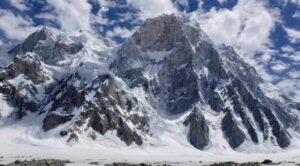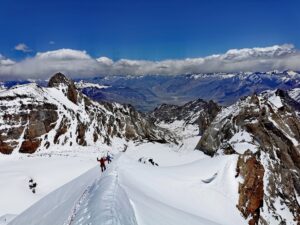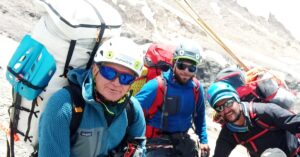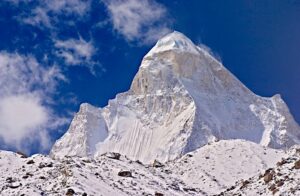A history of remarkable solo climbs on one of the most difficult 8,000’ers.
At 8,463m, Makalu is the fifth highest mountain on Earth. Nineteen kilometres southeast of Everest, Makalu has seen more than 560 successful climbs since its first ascent by Lionel Terray and Jean Couzy in 1955. Almost 50 people have died on its slopes, including 37 who were climbing without supplemental oxygen.
It is never an easy climb. Even in summer, it is very cold with strong winds, and all its routes hide challenges. Despite this, some brave climbers have attempted solo climbs.

The two subsidiary peaks of Makalu: Kangchungtse (aka Makalu II) and Chomo Lonzo. Both are more than 7,000m high. Photo: Wikipedia
1981: Robert Schauer and an almost fatal fall
On April 4, 1981, an Austrian expedition led by Hanns Schell showed up at Makalu Base Camp. Schell’s team included Georg Bachler, Hilmar Sturm, Hans Robert Schauer, and three Sherpas. The group worked on the route leading up to the Northwest Ridge through Makalu La. On April 15, they established Camp 2 at 7,000m.
A few days later, Schauer and the Sherpas climbed to Camp 3 at 7,500m. The Sherpas then returned to Base Camp while Schauer made a solo summit push. On April 25, Schauer topped out alone, without bottled O2.

Makalu (in the background) seen from Ama Dablam. Photo: Ralf Dujmovits.
But during the descent, at around 8,200m, Schauer slipped and fell 100m. He lost his ice ax but was able to arrest his fall using his crampons. There, at 8,100m, he bivouacked overnight before descending safely to Base Camp.
A postcard from Kathmandu

Postcard from Kurtyka to Kukuczka, written in Kathmandu. Photo: Virtual Museum of Jerzy Kukuczka
That spring of 1981, a second group were also on Makalu, led by Wojciech Kurtyka and Alex MacIntyre. First, they completed a very long acclimatization climb to 7,800m on the Northwest Ridge. Next, they tried the West Face, but the route proved so difficult that even this group made it no higher than 6,700m. However, one of their party, Sherpa Padam Singh Ghale, climbed Makalu II alone. It was a historic achievement for Nepalese mountaineering.
After their failed climb, Kurtyka sent a postcard from Nepal to legendary Polish mountaineer Jerzy Kukucka:
Jurek! Come over. I was below the West Face of Makalu with Alex MacIntyre, René Ghilini, and Ludwik Wilczynski, but we failed at a mere 6,700m! I still believe it can be climbed, though. In the Krakow club account, I still have some money left. You have to organize the rest and bring it to Kathmandu. I rely on you! Wojciech
Kukuczka had some trouble gathering enough money for the trip and only had a month to organize everything. Nevertheless, he made it to Nepal, and by September 1981, Kukuczka, Kurtyka, and MacIntyre were together in Makalu Base Camp.

Makalu. Photo: Archil Badriashvili
Kukuczka solo ascent
To acclimatize, they climbed up to 8,000m on the northwest side, and up to 7,900m on the west side. Kurtyka and MacIntyre withdrew from another attempt, but Kukuczka decided to climb the mountain alone, in alpine style, without supplemental O2, and via a new route.

“Up or down? In the end I went up.” — Jerzy Kukuczka. Photo: Kukuczka soloing on Makalu. Virtual Museum of Jerzy Kukuczka
His route followed the left edge of the West Face and finished via the Northwest Ridge. “It was no easy decision to take, the fear of the unknown!” Kukuczka said later. “I would be relying solely on my own ability. I could only succeed if everything went my way.” Everything did go his way, and he reached the summit on October 15.

The West Face of Makalu. Photo: Sebastian Alvaro
Curiously, the Nepalese government did not want to ratify the climb unless the next summiter could testify that Kukuczka had left a Polish doll on the summit, as he had claimed when he arrived at Base Camp. The leader of the other Austrian group on the mountain that season wrote a letter in support of Kukuczka’s climb: “For me [there is] no doubt that Mr. Kukuczka has reached the summit of Makalu. It seems to me, that he is not the type of man who would say something that is not true.”

The West Pillar of Makalu. Photo: Sebastian Alvaro
Anyway, the summit was later ratified. This climb became one of the most spectacular in the history of Makalu.
A solo winter attempt

The never-ending West Pillar of Makalu. Photo: Sebastian Alvaro
In January 1982, French climber Ivan Ghirardini attempted the very difficult West Buttress. Because of extreme cold and strong winds, he didn’t make it, despite an amazing effort. He climbed alpine-style, without O2, with just 120m of rope, and a 25kg backpack. He reached 7,000m despite hurricane-force winds and -50˚C temperatures.
Andrzej Czok
In October 1982, Polish mountaineer Andrzej Czok climbed to 8,000m via a new route up the centre of the West Face. At 8,000m (Camp 4), he met two other mountaineers, Janusz Skorek and Andrzej Machnik. After a night in Camp 4, they climbed within 100m of the summit before strong winds forced them to retreat.

The West Face of Makalu. Photo: Sebastian Alvaro
Skorek and Machnik descended, but Czok stayed in Camp 4. He waited two more days for the wind to calm down. On October 10, he finally got his weather window and topped out from the northwest side.
Romolo Nottaris
Two years later, in September 1984, Swiss climber Romolo Nottaris ascended slightly to the right of the 1981 route. He climbed alone from Camp 2 (6,400m), without supplemental O2. At 6,850m, he picked up some climbing gear that he had stashed the day before, and then continued to ascend, fixing ropes only where necessary.
Nottaris spent a night at 7,800m but a fierce wind — a recurring theme on Makalu — delayed him the next morning. At 11 am, he was finally able to continue toward the summit. He made it by 7 pm, though he suffered frostbite in the process. He descended to 7,500m via the normal route to the North Col, then broke off on a more direct line to Base Camp.
Marc Batard’s speed ascent
On April 27, 1988, French mountaineer Marc Batard ascended via the West Pillar and descended by the Northwest Ridge. He had previously established camps up to 7,750m. He completed the full climb in less than 24 hours, a remarkable achievement.

Strong winds have caused many failures on Makalu. Photo: Sebastian Alvaro
Batard started his solo push from Base Camp, without O2. It was the first solo climb of the West Pillar and the first solo traverse of the mountain.
Some have suggested this should not be classified as a solo climb. Erhard Loretan and Reinhold Messner both criticized the climb, pointing out that Batard’s route had already been equipped.
Pierre Beghin
In October 1989, Pierre Beghin climbed Makalu by a new route. From approximately 7,100m, he made a solitary summit push, ascending a direct route via the South Face and descending by the Northwest Ridge, all without O2.
During the descent, he was hit by two avalanches. The first took one ice ax and the second took his second ax and also his gloves. He later wrote about it in great style.
I glide headfirst at crazy speed, I am submerged, then flung about. I am hurled over two ice walls. Endless seconds! Hideous fear! Four hundred metres lower, the avalanche comes to rest. I am tossed free. With my heart racing, I sit here, totally stupefied.”
Miraculously, Beghin survived.

Pierre Beghin survived two avalanches on Makalu but died three years later on the South Face of Annapurna, when a rappel anchor came out. Photo: Wikipedia
Other solo attempts
There have been a few other notable solo attempts.
In 1993, Jeff Lowe set off up the West Face. He reached 7,000m but was inundated with heavy snow, and his tent was buried by an avalanche. It took Lowe three hours to dig himself out.
In the fall of 1996, Yasushi Yamanoi also made a solo attempt on the West Face. But at 7,400m, he was hit by falling rocks. He decided to retreat because of the pain in his neck and chest.

Jean-Christophe Lafaille at Base Camp of Makalu before his solo winter attempt. Photo: Planet Mountain
French mountaineer Jean-Christophe Lafaille had even worse luck. In 2006, he tried to make the first winter ascent of Makalu. He climbed without O2 and made his high camp at 7,600m. The next morning, he left for the final summit push. He disappeared shortly after.






